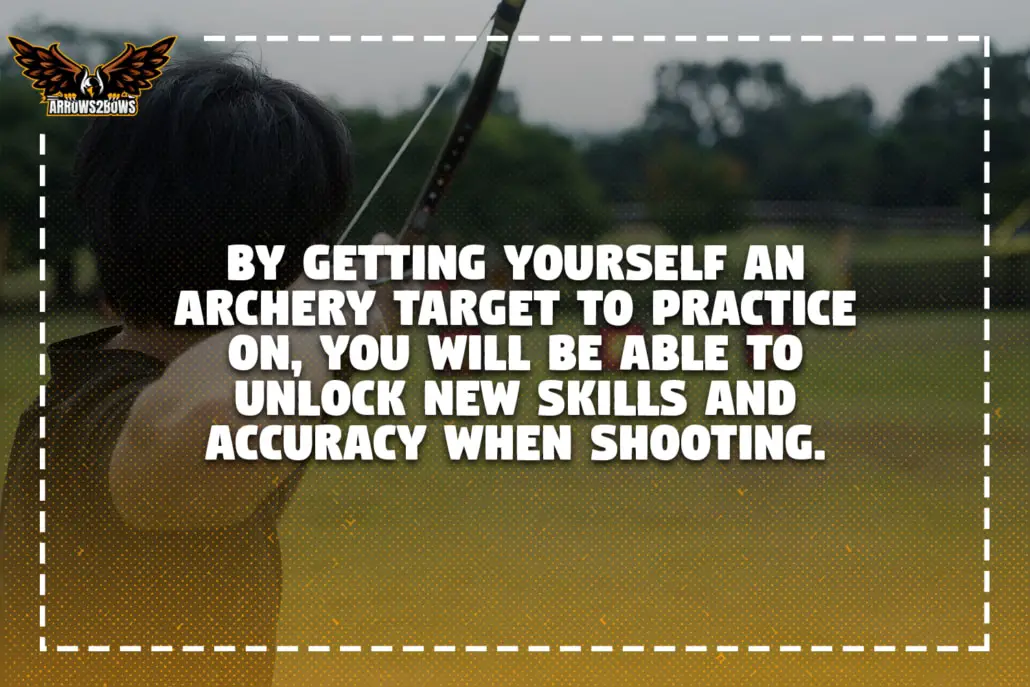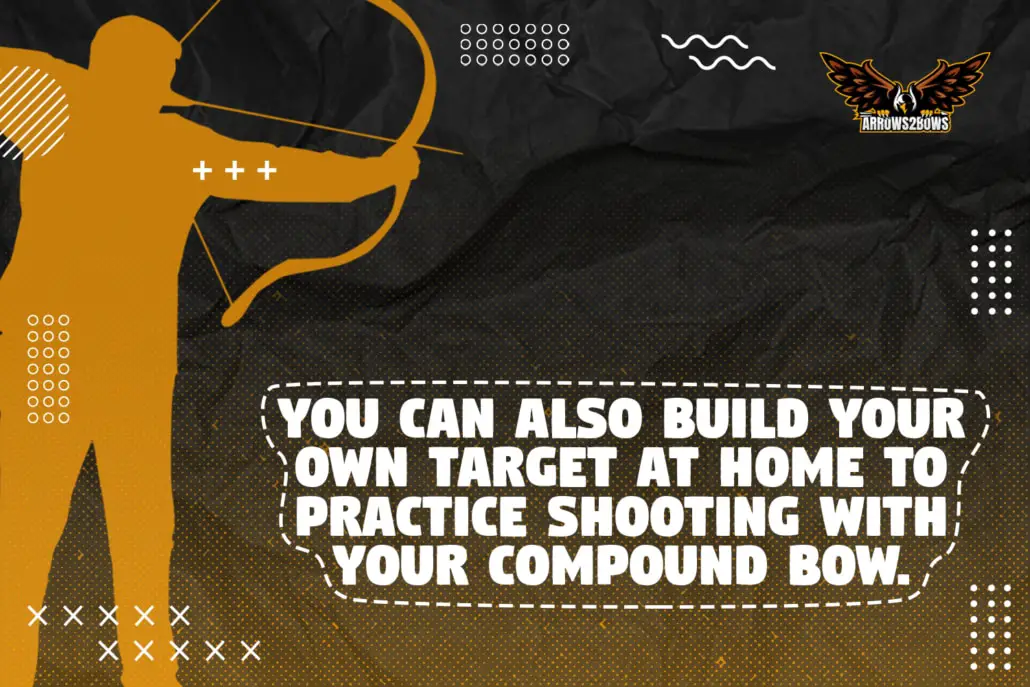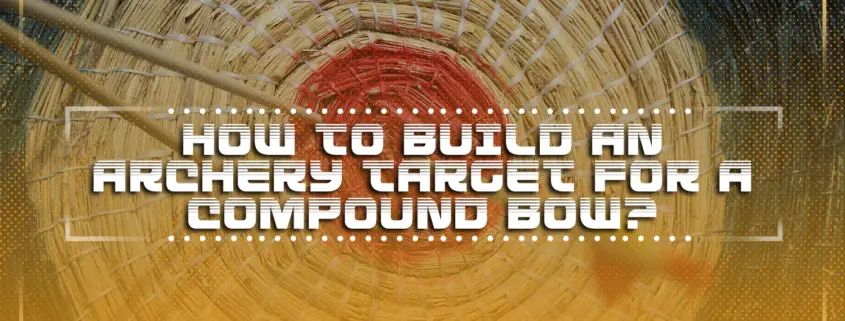How to build an archery target for a compound bow
Whether you are using your bow to hunt animals or are looking to improve your skills as a target archer, the most important thing you have to do is practice.
Similar to any other sport or activity, archery requires you to have time and patience in honing your abilities to their maximum potential so that you can become a skilled archer. While you can’t just pretend to shoot arrows and expect to get better, archers of all levels rely on target practice to improve their overall archery skills and abilities.
By getting yourself an archery target to practice on, you will be able to unlock new skills and accuracy when shooting. Understanding the types of target you can buy, the targets you can make, and the common questions often asked about target shooting for compound bows, will help you assess what will work best for you so that you can start practicing as soon as possible.
There are many types of archery targets you can buy in a store, but you can also build your own target at home to practice shooting with your compound bow. You can build an archery target by simply stacking many layers of cardboard or carpet together or by covering a haybale in plastic.

Why to practice shooting at a target
When considering the investment of money to buy a target or the investment of time if you are considering making your own target, understanding what value a target will provide you is a serious thing to consider.
For years, archers have been making targets of all shapes and sizes so that they could improve their skills. From the old hay targets on poles during the medieval times to the latest in impact technology on modern targets, the tools we use to improve archery skills can range from simplistic to advanced, all depending on what needs you may have.
Whether you are looking to hit the bullseye on an Olympic target or want to perfect you kill shot on a deer shaped target, taking the time to practice your shots on a target will prepare you for some common shots that you may face in a time where your accuracy matters most.
By taking the time to get and actively use a target, you will allow yourself time to practice and get better so your overall skills as an archer can improve as you learn and grow.
In addition to a good target to practice on, you’ll also need a bow. Read here to learn about the best compound bow for target shooting.
Types of targets on the market
If you are hoping to improve your skills in the easiest way possible, you can look into the various types of targets that are currently on the market. These targets range from simple to complex and are all designed to fulfill the needs of different archers and what they need to practice.
Paper
Easily the simplest type of target, paper targets are just pieces of thick paper that can contain a wide variety of shapes and targets, from the classic-colored rings on an Olympic target to animal images. Paper targets are often unable to be reused frequently and are usually put in front of another solid object to prevent the arrow from shooting off to nowhere.
Foam
One of the more common and widely used types of target, foam targets, can be made of soft or dense foam that is specially designed to stop arrows. With the ability of foam to resist frequent impacts, foam targets are great at taking less damage than other variants. However, they often allow arrows to pass all the way through, which can be inconvenient.
Bags
Similar to the foam targets in look and general appearance, bag targets are great for someone looking for a mobile and colorful target that comes in various weights and sizes. Due to the bags being filled with many fibers and stopping materials, they allow for better stopping power than the foam targets and allow for easier removal of the arrows.
3d
Some of the most complex and expensive targets, 3D targets are most often used by hunters who are looking to get an accurate understanding of hunting animals. Composed of foam and other plastics, these targets can range from turkeys to deer and are prefect for the hunter looking to hit targets in a kill zone through practice at home.
Considerations when buying targets
With so many options when it comes to purchasing your own target, there are a few key points of information to consider when choosing your target. No matter what you are looking for, making sure the target you buy will fit your needs and archery style is essential.
By going over four of the most important considerations, you will be able to determine if you would rather purchase or make your own target.
Price
When it comes to buying archery targets from a store, the most frequent downside that archers find is that even for the most basic targets, the price tag can be incredibly high. Bag and block targets cost nearly a hundred dollars and good 3D targets almost always cost over $300, so having to buy multiple targets once old ones wear out can be an expensive process.
If you try to buy cheap targets in the beginning, you will only end up spending more as you have to keep paying more money to replace them over time.
Functionality
Unless you have a shooting range in your house, making sure you are able to move your target into position and set it up many times can determine how much you are willing to use it. While most targets are just filled with foam and fibers, they can be incredibly heavy, even the smaller targets.
Another consideration is that for stands that don’t go on the ground, you will need to buy some sort of stand to get an accurate shot, which can cost quite a bit of money and take extra time to set up.
Durability
One aspect that can differ vastly from target to target is the durability it has and how many shots it can take without breaking or losing its usability. In general, the price you pay for a target often leads to a higher quality with a higher price, but unfortunately that is not always the case.
With you wanting to get as much practice as possible, a target can often experience hundreds or thousands of shots in their lifetime. Making sure to be careful when purchasing your targets will ensure that you are getting a target that can take the hits and last you through many years of practice.
Size
Depending on what kind of shooting you plan on doing and how far you want to shoot from, the size of your target should be a key consideration. From targets the size of a piece of paper to the larger Olympic-style targets, the size of a target primarily depends on your shooting goals and what you plan to be shooting in real life.
Something that is often overlooked is the weight of larger targets, as with a larger area to shoot at comes a heavier target that must be able to be hit in several places.

Benefits of homemade targets
After understanding some of the benefits and pitfalls of targets you can buy in a store, you can now consider if making a target at home would better suit your needs. Homemade targets have many benefits and not as many downsides as store-bought targets, so making a home-made target for your compound bow could be just what you need.
Price
Unlike the targets you will find in many stores, a target that you make at home can often cost little to nothing, depending on what you have lying around at home. From targets made out of spare boxes or extra wood, you can often find a great way to use some of those pieces of scrap you often find lying around your house.
Other than the cost of possibly some extra materials to put together your target frame, the overall cost to make a target at home can be incredibly low and leave you with extra money to buy other essentials for your archery hobby.
Repairability
With a target that you buy in a store, if you shoot at a certain part too many times, it can wear out and leave you having to buy a whole new target altogether. However, if you decide to make a target at home, you will be able to repair any damage to you target with spare materials lying around the house and continue to get use out of the same target.
With the ability to repair and fix any holes or stopping elements of your target, you will save money and time by preventing extra trips to the store to buy entirely new targets.
Adjustability
When you buy a target at the store, your options can often be limited to the patterns on the targets, as well as so many other factors such as size, weight, and stopping power.
When you construct a target at home, the sky is the limit with how you construct your target and set it up at home. Adding more material for better stopping power or increasing the size or shape of the target zone on the target, allows you to customize every aspect of your target to your liking and shooting ability over time.
Types of home targets and how to build them
With an understanding of the many benefits that come with making and using your own target at home, the process of actually making a target may seem daunting, but it’s actually fairly simple. By going through five of the most common home targets and how to put them together, along with a few downsides, you will be able to form a decision as to which target will be best for you.
Cardboard
For the archer looking to get some shooting done without much time or materials on their hands, the cardboard target is perfect for you. Taking only a few materials to set up and minutes to complete, the cardboard target can be as basic or as complex as you’d like to make it.
To start, find yourself a nice big box for the target you want to make. If you don’t have a spare box lying around at home, many department stores have extras if you ask and can probably get some there for free.
Once your initial box is picked you, you’ll want to stack about thirty sheets of carboard on top of each other using glue and tape and then stick that to the inside of your main box. This method will provide an easy-to-assemble and replace target. The major downside is its short lifespan before needing to be replaced.
Hay
Since the earliest days of archery, hay has been used to make targets and for good reason. With its cheap cost and natural ability to stop arrows, hay makes a great at home target that can be made very easily.
To start, find a hay bale that is either in the shape of a circle or just a standard cube. On its own hay can work as a target, but to get the most out of the hay it is best to cover it in a plastic cover to make an actual target on the hay.
While it is simple to use and cheap, hay has its downsides. The major issue with hay is that it can fall apart very quickly and will most likely last about as long as the cardboard. The other issue with hay is that it is just dry grass, so it can get wet in the rain or eaten by animals. You will have to bring it inside when not in use.
Foam mats
If you have ever browsed the home-gym section of your local store, you may have notices sets of black, interlocking mats that are used to go on the floor of a gym. One unusual yet incredibly practical use for these mats is the ability to make them into a very durable targets that are on par with store-bought targets.
To make one of these targets, you will need to get a lot of the foam floor tiles. Depending on the size of your desired target, you should stack and attach these foam panels together to create a thickness of around one foot or thicker.
To contain the panels, make a wooden frame to keep the target together and adjust it to whatever size target you may want. The biggest downside to this target is that with its many materials, it can get about as expensive as many store-bought targets.
Carpet
For the archer who has some leftover carpet lying around from a home renovation, you may be able to construct a target with little more than some leftover carpet and wood. Due to its assembly, this target can be easy to repair and assemble with it containing only a few parts.
To assemble this target, you will first need to get a lot of carpet. You can use the cheapest kinds available to save on price, but you will need enough to stack up as high as you want your target to sit. Once you have the carpet, get two pieces of sturdy wood and effectively create a carpet sandwich with it and drive four rods into the corners to keep the target secure.
Make sure to compress the carpeting and wood as much as possible so that you can ensure the carpet absorbs the shock more effectively. While this target is easy to make and repair, unless you have excessive amounts of carpet lying around, it can be a little bit expensive.
Common questions about targets
With so many variations of homemade and store-bought targets to choose from, there are often many questions that archers have when picking out their targets. Below, are some of the most common target-making questions will be answered to help you make your decision.
What material is used for archery targets?
Depending on the type of target used in archery, the type of materials used to construct the targets can vary greatly. For example, many store-bought targets are constructed out of special foams and polymers that are designed to resist impact and take multiple arrow shots without losing their strength.
However, you can also make archery targets at home with materials like, wood, carboard, hay, and much more to practice your shooting. These materials often cost less than the more expensive variants purchased in stores.
Will a hay bale stop an arrow?
With hay being one of the oldest and most commonly used targets for archers throughout time, hay is often considered to be one of the best ways to stop an arrow for a reasonable price. Hay is cheap and can stop most arrows, so it can be used by a wide range of archers to practice shooting on a respectable target.
Most hay will be able to stop arrows, but hay that is on the thicker side can often be most effective. However, despite all of its benefits, hay does have the downside. It can break apart after heavy usage and also loses its functionality when wet.
How thick should an archery target be?
Depending on the material it is constructed of and the arrows you are shooting with, the thickness of an archery target can differ greatly depending on a few factors. The most common factor that determines a target’s thickness is what it is made out of.
For example, a target that is made out of foam will not need to be as thick as a bag target that needs extra space to stop an arrow. The arrow you shoot at the target can also require different levels of thickness. A large, broadhead arrow will need much more stopping power than a much lighter practice arrow.
Read here to find out more information about the best arrows for compound bows.
How long do archery targets last?
The lifespan of an archery target greatly depends on how you make it and what it is made of. A foam pad that is made in a professional target has been built and designed to be shot by arrows, so these targets can last for thousands of shots.
If you want to make a homemade target out of cardboard, then you will need to replace the interior padding with more cardboard after only a few shots to a certain area.
What are the best archery targets?
For those archers looking to get into competitive archery, the best targets would be the ones that are used by the professionals and are the same size as the competitive targets.
If you are looking to hunt specific animals with your compound bow, it is a good idea to look at getting an archery target that resembles the animal you’re hunting, so that when you are practicing, you can aim for the kill zones that ensure a one-shot kill on the animal.
Making sure that your targets are suited for your style and frequency of use will ensure that you are getting the most value out of your build or purchase.
What is the center of an archery target called?
Depending on the target you are shooting, the center of the target is most commonly referred to as the bullseye. When aiming at a circular target, the bullseye will be the small area in the center that should be colored yellow. When competing in archery, the goal of most competitions is to try and hit this area as frequently as possible, in order to get the most points.
Final thoughts
From the most basic of targets to life-like animal targets, there is an incredibly diverse and expansive range of targets that can help you improve your archery skills. Whether you have decided to grab some carboard to make your very own box target or you are planning to go to a hunting store to see what best fits your style, you will be happy in knowing that whatever you practice with, your archery will see vast improvements.



